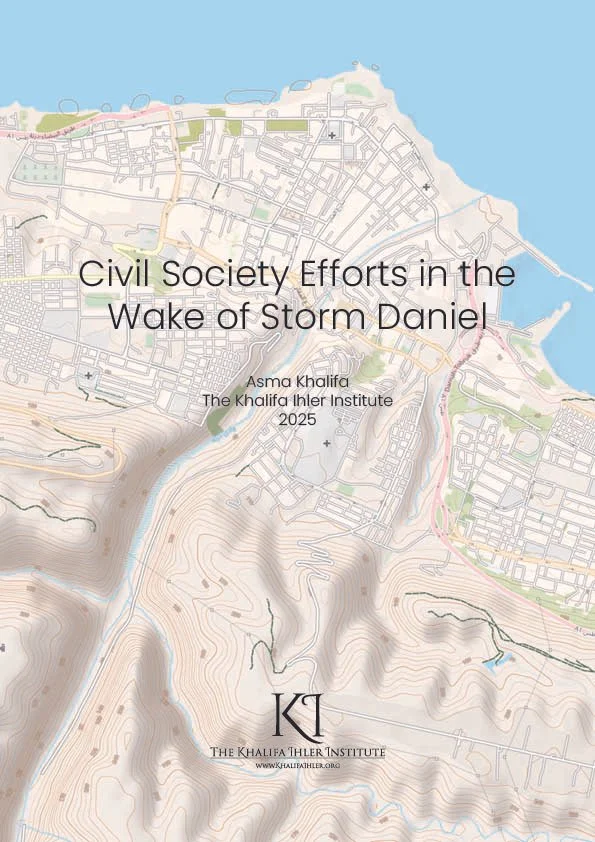Civil Society Efforts in the Wake of Storm Daniel - جهود المجتمع المدني في الإستجابة لكارثة إعصار دانيل
On September 10th, 2023, Storm Daniel reached Libya and wreaked havoc upon the lives of thousands of people who continue to struggle in their survival. There are numerous documented stories of the survivors of the storm, who shared poignant personal accounts of unimaginable loss. The catastrophic impact of the storm revealed the vulnerability of Libya's crisis response mechanisms and the inadequacy of its fragmented governance system to coordinate and mobilize resources to safeguard vulnerable populations effectively. Natural disasters in conflict zones present unique challenges and exacerbate existing vulnerabilities. In conflict zones, the impact of disasters is often magnified because of weakened infrastructure, limited resources, and disrupted governance systems.
Conflict-affected populations are often already struggling with displacement, food insecurity, and limited access to basic services. Natural disasters can add additional stress and challenges to these fragile situations. This report examines the aftermath of the storm, with a focus on civil society efforts and community responses in affected areas, such as Derna. Through interviews with local organisations and activists, this study analysed the challenges faced before, during, and after the disaster, highlighting issues such as the lack of early warning systems, poor infrastructure, and gaps in government response.
The report explores the grassroots mobilisation of citizens, particularly women and youth, who played crucial roles in providing immediate relief. It also examines the broader implications of the disaster, including its gendered impacts and the complexities of its reconstruction efforts. Through a critical examination of these issues, the report seeks to provide more effective, equitable, and sustainable approaches to disaster preparedness, response, and recovery in Libya.
The key areas covered include the following: pre-existing vulnerabilities that exacerbated the storm's impact, community-led disaster response initiatives, challenges in aid distribution and coordination, and gendered dimensions of disaster and recovery.
في العاشر من سبتمبر 2023، وصلت عاصفة دانيل إلى ليبيا وأحدثت دمارًا هائلاً في حياة الآلاف من الناس الذين ما زالوا يكافحون من أجل إعادة البناء. هناك العديد من القصص الموثقة للناجين من العاصفة، الذين شاركوا روايات شخصية مؤثرة عن خسائر لا يمكن تصورها.1 كشف التأثير الكارثي للعاصفة عن ضعف آليات الاستجابة للأزمات في ليبيا وعدم كفاية نظام الحكم المجزأ لتنسيق وتعبئة الموارد بشكل فعال لحماية السكان المعرضين للخطر. تفرض الكوارث الطبيعية في مناطق الصراع تحديات فريدة وتؤدي إلى تفاقم نقاط الضعف القائمة. في مناطق الصراع، غالبًا ما يتضخم تأثير الكوارث بسبب ضعف البنية الأساسية والموارد المحدودة وأنظمة الحكم المعطلة.
غالبًا ما يعاني السكان المتضررون من الصراعات المسلحة من النزوح وانعدام الأمن الغذائي والوصول المحدود إلى الخدمات الأساسية. يمكن للكوارث الطبيعية أن تضيف ضغوطًا وتحديات إضافية إلى هذه المواقف الهشة. يدرس هذا التقرير عواقب العاصفة، مع التركيز على جهود المجتمع المدني واستجابات المجتمع في المناطق المتضررة، مثل درنة. من خلال المقابلات مع المنظمات والناشطين المحليين، قامت هذه الدراسة بتحليل التحديات التي واجهتها المنظمات والمجتمعات المحلية قبل وأثناء وبعد الكارثة، مع تسليط الضوء على قضايا مثل الافتقار إلى أنظمة الإنذار المبكر، والبنية التحتية الرديئة، والثغرات في استجابة الحكومة.
يستكشف التقرير التعبئة الشعبية للمواطنين، وخاصة النساء والشباب، الذين لعبوا أدوارًا حاسمة في تقديم الإغاثة الفورية. كما يدرس الآثار الأوسع نطاقًا للكارثة، بما في ذلك آثارها الجنسانية وتعقيدات جهود إعادة الإعمار. من خلال الفحص النقدي لهذه القضايا، يسعى التقرير إلى تقديم نهج أكثر فعالية وإنصافًا واستدامة للاستعداد للكوارث والاستجابة لها والتعافي منها في ليبيا.
تشمل المجالات الرئيسية التي يغطيها التقرير ما يلي: نقاط الضعف السابقة التي أدت إلى تفاقم تأثير العاصفة، ومبادرات الاستجابة للكوارث التي تقودها المجتمعات المحلية، والتحديات في توزيع المساعدات وتنسيقها، والأبعاد الجنسانية للكوارث والتعافي منها. الصحة العقلية والتأثيرات النفسية، وجهود إعادة الإعمار الجارية، والمخاوف المرتبطة بها.

